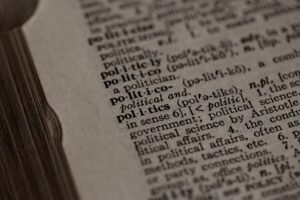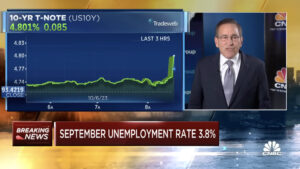
When you make purchases through our links we may earn a small commission.

Photo Credit: Jp Valery
Put It On Your Wall: CanvasOnDemand.com
Support thesmokingchair.com through Patreon.
The COVID-19 pandemic presented an unprecedented global challenge, demanding swift and effective responses from governments worldwide. However, the gross mismanagement of this crisis has resulted in a cascade of largely preventable consequences, including financial losses, fraud, death, disability, labor shortages, supply chain chaos, and inflationary reactions. In this article, we delve into the multifaceted repercussions of mismanagement, shedding light on the interconnected web of challenges that emerged in the wake of poor decision-making.
Financial Losses
The financial fallout from the mismanagement of the COVID-19 pandemic has been nothing short of staggering, with far-reaching consequences across various sectors of the global economy. Governments, grappling with the dual challenges of safeguarding public health and maintaining economic stability, often found themselves making decisions that exacerbated rather than alleviated financial strains.
Lockdown measures, while crucial for controlling the spread of the virus, dealt a severe blow to businesses, particularly in the hospitality, travel, and entertainment sectors. Small enterprises, lacking the financial cushion of larger corporations, faced closures, bankruptcies, and unprecedented revenue declines. The abrupt disruptions to normal economic activity resulted in millions of job losses, creating a ripple effect through local and international labor markets.
Government responses, marked by inconsistencies and delays, further fueled economic uncertainty. Stimulus packages aimed at supporting businesses and individuals varied widely in effectiveness and distribution, with some regions experiencing a lack of access to crucial financial lifelines. The mismanagement of relief programs not only failed to provide sufficient aid but also opened the door to widespread fraud, diverting funds away from those who needed them most.
Stock markets, once considered indicators of economic health, experienced unprecedented volatility. The unpredictable nature of government interventions and the lack of a unified global response left investors grappling with uncertainty, contributing to wild swings in financial markets. The resulting instability had profound implications for pension funds, retirement savings, and long-term investments, impacting individuals and institutions alike.
Moreover, the financial losses incurred during the pandemic had a cascading effect on public services. Governments, grappling with shrinking revenues and increasing demands for healthcare and social support, faced unprecedented fiscal challenges. Balancing the need for economic stimulus with the imperative to rein in ballooning deficits became a delicate tightrope walk, requiring policymakers to navigate uncharted waters.
As nations reflect on the economic toll of the pandemic mismanagement, there is a pressing need for coordinated global efforts to stabilize and revitalize economies. The lessons learned from this crisis should inform future policies, emphasizing the importance of preparedness, swift and effective decision-making, and the necessity of a robust economic framework capable of withstanding unforeseen challenges.
Fraud
The mismanagement of the COVID-19 pandemic created fertile ground for a parallel crisis – a surge in fraudulent activities that exploited weaknesses in relief measures and exposed vulnerabilities in oversight. Governments, under immense pressure to rapidly deploy financial aid and support programs, inadvertently opened the door for opportunistic fraudsters to siphon funds away from those in genuine need.
One of the primary conduits for fraud was the implementation of relief packages designed to provide financial assistance to struggling businesses and individuals. As governments rushed to disburse funds, the lack of robust verification processes and insufficient oversight allowed fraudulent claims to slip through the cracks. Fake businesses, fictitious employees, and identity theft became rampant, diverting funds meant for economic recovery into the hands of criminals.
The sheer scale and speed at which relief programs were rolled out made it challenging for authorities to conduct thorough due diligence. Fraudsters capitalized on the chaos, submitting inflated claims, exploiting loopholes, and taking advantage of overwhelmed government agencies. In some cases, organized criminal networks engaged in large-scale fraud schemes, diverting millions of dollars from legitimate recipients.
Compounding the issue was the lack of a unified approach to combat fraud across borders. As fraudsters adapted to exploit weaknesses in one jurisdiction, they often shifted their focus to another, making it difficult for law enforcement agencies to track and apprehend those responsible. The global nature of the pandemic exacerbated these challenges, requiring international cooperation to tackle a crisis that transcended geographical boundaries.
The consequences of fraud extended beyond immediate financial losses. Legitimate businesses, already reeling from the economic impact of the pandemic, found themselves competing for limited resources with fraudulent entities. This further strained the effectiveness of relief measures, hindering the intended economic recovery.
Addressing the issue of fraud requires a multifaceted approach. Governments must invest in robust verification systems, leveraging technology to enhance the accuracy and efficiency of screening processes. International collaboration is essential to share intelligence and coordinate efforts to identify and apprehend transnational fraud networks. Additionally, public awareness campaigns can educate individuals and businesses about the signs of fraudulent activity, fostering a collective commitment to combatting this shadow pandemic.
As nations confront the aftermath of the COVID-19 mismanagement, addressing the vulnerabilities that allowed fraud to flourish is crucial for restoring public trust, safeguarding economic recovery efforts, and preparing for future crises with resilience and vigilance.
Death and Disability
The mismanagement of the COVID-19 pandemic has exacted a devastating toll on human life and well-being, with inadequate crisis responses exacerbating the impact on public health. Inconsistent policies, delayed interventions, and overwhelmed healthcare systems have collectively contributed to an escalation of death and disability on a global scale.
The delayed and, at times, fragmented implementation of public health measures allowed the virus to spread rapidly, overwhelming healthcare infrastructure and frontline workers. Insufficient testing, contact tracing, and a lack of coordinated responses left communities vulnerable to unchecked transmission, resulting in a higher number of infections and, consequently, a surge in fatalities.
In some instances, the mismanagement of healthcare resources and the prioritization of political considerations over evidence-based decision-making have led to a scarcity of critical medical supplies, exacerbating the challenges faced by frontline healthcare workers. Shortages of personal protective equipment (PPE), ventilators, and other essential medical resources have compromised the ability of healthcare systems to provide optimal care, amplifying the strain on medical professionals and impacting patient outcomes.
The vaccine distribution process, marked by delays, inequities, and logistical challenges, further prolonged the battle against the virus. In regions where vaccination campaigns were hindered by mismanagement, vaccine hesitancy, or supply chain disruptions, the consequences were severe. Preventable deaths occurred as vulnerable populations remained unprotected, highlighting the direct correlation between effective crisis management and lives saved.
Beyond the immediate loss of life, a significant number of survivors have faced enduring health consequences. Known as “long COVID,” this condition manifests as a range of persistent symptoms, including fatigue, shortness of breath, and cognitive impairment, among others. The mismanagement of the pandemic has contributed to the underestimation and inadequate recognition of the long-term health impacts, leaving survivors without sufficient support and healthcare resources.
Disparities in healthcare access and outcomes have also been exacerbated, disproportionately affecting marginalized communities. The mismanagement of the pandemic laid bare existing inequities in healthcare systems, with vulnerable populations experiencing higher rates of infection, death, and long-term disability.
Addressing the human toll of the pandemic requires a comprehensive and compassionate approach. Governments and healthcare systems must prioritize evidence-based decision-making, invest in robust public health infrastructure, and ensure equitable access to vaccines and healthcare resources. Recognizing and addressing the long-term health impacts of COVID-19 is essential for providing comprehensive support to survivors and building resilient healthcare systems prepared for future health crises. As societies reflect on the profound impact of mismanagement, the imperative to prioritize human life and well-being in crisis responses becomes a paramount consideration for future global challenges.
Labor Shortages
The mismanagement of the COVID-19 pandemic has triggered a complex and interconnected crisis, extending beyond public health to disrupt global labor markets. Inconsistent lockdown measures, inadequate protection for essential workers, and delayed vaccination campaigns have collectively contributed to widespread labor shortages, creating a ripple effect across industries and exacerbating the economic challenges induced by the pandemic.
Lockdowns, implemented with the intention of slowing the spread of the virus, inadvertently disrupted the normal functioning of businesses and industries, leading to mass layoffs and furloughs. Sectors reliant on manual labor, such as manufacturing, agriculture, and construction, experienced acute disruptions as workers were unable to perform their duties. These disruptions not only impeded production and service delivery but also contributed to a protracted economic downturn.
Essential workers, including healthcare professionals, grocery store employees, and delivery workers, faced heightened risks of exposure to the virus due to inadequate protective measures. The mismanagement of crisis responses, including delays in providing adequate PPE, testing, and vaccination, further exacerbated the risks faced by these frontline workers. As infections spread among essential workers, labor shortages became more pronounced, affecting the critical functions that sustained societies during the pandemic.
Global supply chains, intricately linked and dependent on the steady flow of labor, experienced severe disruptions. Manufacturing plants faced production delays, shipping and transportation services struggled to meet demand, and agricultural activities were hampered by the absence of workers. These challenges, compounded by the mismanagement of public health measures, led to shortages of goods and services, contributing to a cycle of economic uncertainty.
The strain on labor markets extended beyond immediate job losses. Workers who contracted the virus and survived faced lingering health issues, contributing to absenteeism and diminished productivity. Additionally, the mental health toll on workers, exacerbated by the anxieties surrounding the pandemic and the challenges of adapting to remote work or altered working conditions, further impacted overall workforce effectiveness.
Mitigating the impact of labor shortages requires a multifaceted approach. Governments and businesses must prioritize the health and safety of workers, implementing comprehensive measures to protect essential employees and facilitate a safe return to work. Investments in upskilling and reskilling programs can help workers adapt to evolving job requirements, fostering a more resilient and versatile workforce.
International collaboration is essential to address the global nature of labor shortages, particularly in industries with interconnected supply chains. Governments and organizations must work together to streamline immigration policies, facilitate the movement of essential workers, and address the challenges posed by disrupted labor markets.
As nations grapple with the economic repercussions of labor shortages, the lessons learned from the mismanagement of the pandemic underscore the importance of proactive and coordinated efforts to safeguard global workforces against future crises. Prioritizing the resilience of labor markets is not only critical for economic recovery but also essential for building a foundation that can withstand the challenges of tomorrow.
Supply Chain Chaos
The mismanagement of the COVID-19 pandemic has precipitated a profound disruption in global supply chains, underscoring the fragility and interconnectedness of the modern economy. As the virus spread, containment measures, logistical challenges, and a lack of coordinated responses created a perfect storm, amplifying the chaos within supply networks and reverberating across industries worldwide.
Lockdowns and restrictions on movement, implemented to curb the spread of the virus, disrupted the normal flow of goods and services. Manufacturing facilities faced closures, transportation networks experienced delays, and borders were sealed, impeding the timely movement of raw materials and finished products. These disruptions, coupled with the mismanagement of crisis responses, led to a domino effect across industries, causing shortages, delays, and inefficiencies.
One of the primary challenges was the unpredictability of the pandemic’s impact on different regions. As the virus surged in one area, supply chains dependent on production from that region experienced interruptions. This variability, exacerbated by a lack of contingency planning, made it difficult for businesses to anticipate and mitigate disruptions, leading to increased vulnerability to unforeseen challenges.
The mismanagement of information and communication further fueled supply chain chaos. Inconsistent guidelines, policy reversals, and a lack of transparency in decision-making processes left businesses grappling with uncertainty. Without clear guidance, companies struggled to make informed decisions about production, distribution, and inventory management, contributing to bottlenecks and inefficiencies.
Global demand for certain products, particularly those related to healthcare and home entertainment, experienced unprecedented spikes. The mismanagement of crisis responses, coupled with supply chain disruptions, led to shortages of critical medical supplies, electronic components, and other essential goods. The resulting scarcity not only impacted public health and safety but also created a surge in demand for alternative suppliers, further straining logistics networks.
The reliance on just-in-time inventory practices, while efficient in normal circumstances, magnified the impact of disruptions during the pandemic. Businesses operating with minimal stockpiles found themselves ill-equipped to weather the storm of unpredictable challenges, leading to shortages and delays that rippled through supply chains.
Addressing supply chain chaos necessitates a paradigm shift in how businesses approach resilience and risk management. Diversifying supplier networks, investing in digital technologies for real-time tracking and visibility, and adopting more flexible inventory strategies are crucial steps toward building resilient supply chains capable of withstanding future shocks.
International collaboration is also essential to address the global nature of supply chain disruptions. Governments, industry stakeholders, and international organizations must work together to establish standards, share best practices, and develop contingency plans that can mitigate the impact of future crises on the interconnected web of global supply chains.
As nations reflect on the lessons learned from the mismanagement of the COVID-19 pandemic, the imperative to fortify supply chains against future shocks becomes a central consideration for fostering economic stability and global resilience.
Inflation
The gross mismanagement of the COVID-19 pandemic has left an indelible mark on the global economy, with one of the most pressing and enduring consequences being the surge in inflationary pressures. The interconnected web of disruptions, ranging from labor shortages and supply chain chaos to fiscal policies aimed at economic stimulus, has collectively contributed to a complex economic landscape characterized by rising prices, increased production costs, and heightened uncertainty.
Governments worldwide responded to the economic fallout of the pandemic with expansive fiscal measures, injecting massive amounts of liquidity into their economies to support businesses, workers, and public services. While these stimulus packages were essential for preventing a complete economic collapse, the sheer scale and speed of their implementation had unintended consequences, including inflationary pressures.
The disruptions to global supply chains played a pivotal role in driving inflation. Shortages of essential goods, raw materials, and intermediate products resulted in increased production costs for businesses. These higher costs were often passed on to consumers in the form of elevated prices for goods and services. The surge in demand for certain products, coupled with constrained supply, further fueled inflationary pressures, creating a situation where the purchasing power of currencies eroded rapidly.
Labor shortages, another consequence of mismanagement, contributed to wage pressures. With businesses struggling to find and retain skilled workers, wages were driven upwards, and these increased labor costs were passed on to consumers. As workers sought compensation for the heightened health risks and disruptions to their livelihoods, the inflationary cycle gained momentum.
The economic uncertainty stemming from mismanagement and the prolonged nature of the crisis added another layer to inflationary pressures. Businesses, uncertain about future demand and supply chain stability, became more risk-averse, leading to increased prices as a way to hedge against unforeseen challenges. Consumers, in turn, faced higher costs of living, impacting their purchasing power and consumption patterns.
The inflationary consequences were not uniform across sectors. Industries that were directly impacted by supply chain disruptions, such as automotive and electronics, experienced significant price increases. Meanwhile, the housing market, buoyed by low-interest rates and increased demand, witnessed soaring home prices, contributing to overall inflationary pressures.
Central banks faced the delicate task of managing inflation while supporting economic recovery. The challenge lay in striking the right balance between addressing immediate economic concerns and preventing a sustained inflationary spiral that could erode the purchasing power of currencies and destabilize financial markets.
As nations grapple with the aftermath of pandemic mismanagement, addressing inflation requires a nuanced and multifaceted approach. Policies aimed at rebuilding supply chains, supporting workforce development, and implementing targeted fiscal measures can help alleviate inflationary pressures. Transparent communication from central banks and governments is crucial for managing expectations and restoring confidence in economic stability.
Learning from the missteps of the past, nations must navigate the path toward economic recovery with a keen understanding of the intricate factors contributing to inflation. A concerted effort to address the root causes and implement forward-thinking policies will be essential for restoring balance to global economies and fortifying against the persistent threat of inflation.
Deteriorated Public Trust in Medical Institutions and Scientists
Perhaps one of the most insidious consequences of the mismanagement of the COVID-19 pandemic has been the erosion of public trust in medical institutions and the scientific community. The pandemic demanded a coordinated and transparent response, yet inconsistent messaging, conflicting recommendations, and policy reversals created confusion and sowed seeds of doubt.
The rapid development and approval of vaccines, a remarkable scientific achievement, became a victim of skepticism fueled by misinformation and a lack of clear communication. Conspiracy theories, propagated through social media and other channels, exploited the uncertainties surrounding the pandemic, leading to vaccine hesitancy and reluctance to follow public health guidelines.
The mismanagement of information and the perceived lack of transparency in decision-making processes have strained the relationship between the public and medical authorities. In some instances, public health measures were undermined by political considerations rather than adherence to scientific evidence, further eroding trust.
Rebuilding public trust in medical institutions and scientists requires a commitment to transparency, clear communication, and evidence-based decision-making. Governments and health organizations must prioritize open dialogue, providing the public with accurate information and acknowledging the uncertainties inherent in managing a novel virus. Efforts to combat misinformation, promote scientific literacy, and engage with communities are crucial in restoring confidence in the institutions responsible for safeguarding public health.
The long-term consequences of this erosion of trust extend beyond the current pandemic, impacting future public health initiatives and responses to emerging crises. Rebuilding trust will be essential to fostering a collaborative relationship between the public and the scientific community, ensuring that future challenges are met with unity and confidence in the guidance provided by experts.
The Last Word
The gross mismanagement of the COVID-19 pandemic has left an indelible mark on societies worldwide. From financial losses and fraud to death, disability, labor shortages, supply chain chaos, and inflation, the consequences of poor decision-making continue to unfold. As nations reflect on their responses to the crisis, there is an urgent need for accountability, transparency, and international cooperation to mitigate the long-term effects and prevent similar mismanagement in future global challenges.
You’ll get more articles like this – and our favorite promotional offers delivered straight to your inbox.
By submitting this form you agree to our terms and conditions. You can unsubscribe at any time.

GFYG: Fashion Nova Halloween Costume Haul 2023

Video: Scarlett Blahyj SHEIN TRY ON HAUL (HOLIDAY OUTFITS)

GFYG: Transparent/See-Through | Try On Haul | Lingerie & Dresses

GFYG: Bikini Try-On Haul + BOOMBA Review

NAUGHTY CHRISTMAS LINGERIE TRY-ON HAUL *HOT* | Lauren Alexis


The Citizen’s Dividend: Securing Prosperity in the Age of AI

Trump Repeats Many Claims in Fox News Town Hall























